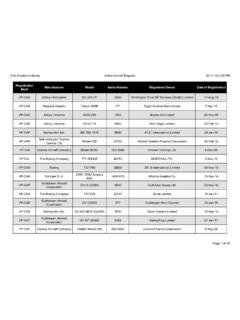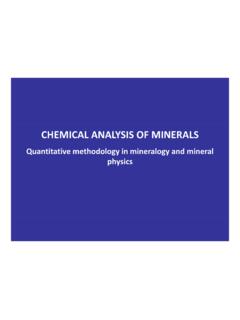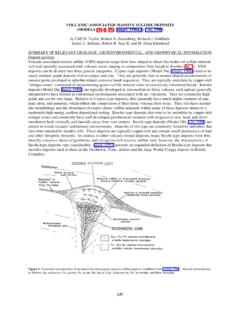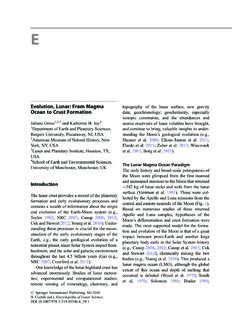Transcription of Basic Relationships of Well Log Interpretation
1 1 Basic Relationships of Well Log InterpretationINTRODUCTIONThis chapter provides a general introduction to welllogging principles and methods that will be usedthroughout the book. Succeeding chapters (2 through6) introduce the reader to specific log types. The textdiscusses how different log types measure variousproperties in the wellbore and surrounding formations,what factors affect these measurements, where on astandard log display a particular curve is recorded, andhow interpreted information is obtained from the logsusing both charts and mathematical formulas.
2 Unlikemany other logging texts, the logging tools aregrouped according to their primary Interpretation tar-get, rather than their underlying measurement potential (SP) and gamma ray logs arediscussed first, as their primary use is correlation andtheir primary interpretive target is gross lithology (thedistinction between reservoir and nonreservoir). Theporosity logs ( , sonic, density, and neutron logs) arecovered next, then the resistivity logs. Nuclear mag-netic-resonance logs, although they provide porosity(among other quantities of interest), are presented afterresistivity logs.
3 This is due in part to their recentarrival and to their relative absence in historical final four chapters again deal with interpreta-tion of the data, this time in detail with example prob-lems and their solutions. These chapters bring theintroductory material of Chapter 1 together with thespecific measurement information and are intended toprovide a coherent view of the Interpretation reader is encouraged to work the examples to gainfamiliarity with the Interpretation techniques and tobegin to understand the limitations on interpretationthat are present due to the nature of subsurface use of charts and simple calculations through-out the text, rather than the use of petrophysical com-puter software, is intentional.
4 It is only through expe-rience with such manual methods that the reader cangain an appreciation for the effects of parameters onthe calculations, and gain a better understanding of theaccuracy and precision of the techniques the first edition of this book was published,virtually all well-logging data were acquired throughthe use of wireline-conveyed tools; that is, loggingtools lowered in the borehole on a 7-conductor cableover which power, operating instructions, and datawere sent. Since the mid-1980s, a second formation-evaluation technique, measurement while drilling(MWD) or logging while drilling (LWD), has devel-oped.
5 In this method, the logging sensors are imbed-ded in the thick-walled drill collars used at the bottomof the drill string (near the bit), and measurement offormation properties is done continuously during thedrilling process (hence the name, MWD). Initially,MWD logging technology borrowed heavily fromwireline technology, with the goal being to produceLWD measurements comparable to wireline measure-ments. As LWD technology has progressed, sensordesign and other features of LWD have been incorpo-rated back into wireline technology, for the improve-ment of those measurements.
6 Unless specifically noted in the text, the interpreta-tion of borehole data is the same irrespective of thesource of the data, either wireline or LWD sensors andmeasurement systems. The techniques shown here areapplicable to both data sources and can even beextended to incorporate equivalent core logging tools and interpretive methods aredeveloping in accuracy and sophistication, they areplaying an expanded role in the geological decision-1 Asquith, G., and D. Krygowski, 2004, Basic Relation-ships of Well Log Interpretation , inG. Asquith andD.
7 Krygowski, Basic Well Log Analysis: AAPG Meth-ods in Exploration 16, p. 1 20. 8/5/04 10:42 AM Page 1making process. Today, petrophysical log interpreta-tion is one of the most useful and important toolsavailable to a petroleum their traditional use in exploration to corre-late zones and to assist with structure and isopachmapping, logs help define physical rock characteristicssuch as lithology, porosity, pore geometry, and perme-ability. Logging data are used to identify productivezones, to determine depth and thickness of zones, todistinguish between oil, gas, or water in a reservoir,and to estimate hydrocarbon reserves.
8 Also, geologicmaps developed from log Interpretation help withdetermining facies Relationships and drilling , the importance of petrophysics and well-log analysis is becoming more evident as more atten-tion is being devoted to the ongoing management ofreservoirs. The industry is realizing the importance ofdetailed petrophysical analyses, based on the details ofthe available data in monitoring, simulating, andenhancing reservoir performance to maximize thereturn on the various types of logs, the ones used most fre-quently in hydrocarbon exploration are called open-hole logs.
9 The name open hole is applied becausethese logs are recorded in the uncased portion of thewellbore. All the different types of logs and theircurves discussed in this text are of this geologist s first exposure to log interpretationcan be a frustrating experience. This is not onlybecause of its lengthy and unfamiliar terminology, butalso because knowledge of many parameters, con-cepts, and measurements is needed before an under-standing of the logging process is the best way to begin a study of logging isby introducing the reader to some of the Basic con-cepts of well log analysis.
10 Remember that a boreholerepresents a dynamic system; that fluid used in thedrilling of a well affects the rock surrounding the bore-hole and, therefore, log measurements. In addition, therock surrounding the borehole has certain propertiesthat affect the movement of fluids into and out of two primary parameters determined from welllog measurements are porosity and the fraction of porespace filled with hydrocarbons ( , hydrocarbon satu-ration). The parameters of log Interpretation are deter-mined directly or inferred indirectly and are measuredby one of three general types of logs: electrical nuclear acoustic or sonic logsThe names refer to the sources used to obtain themeasurements.






